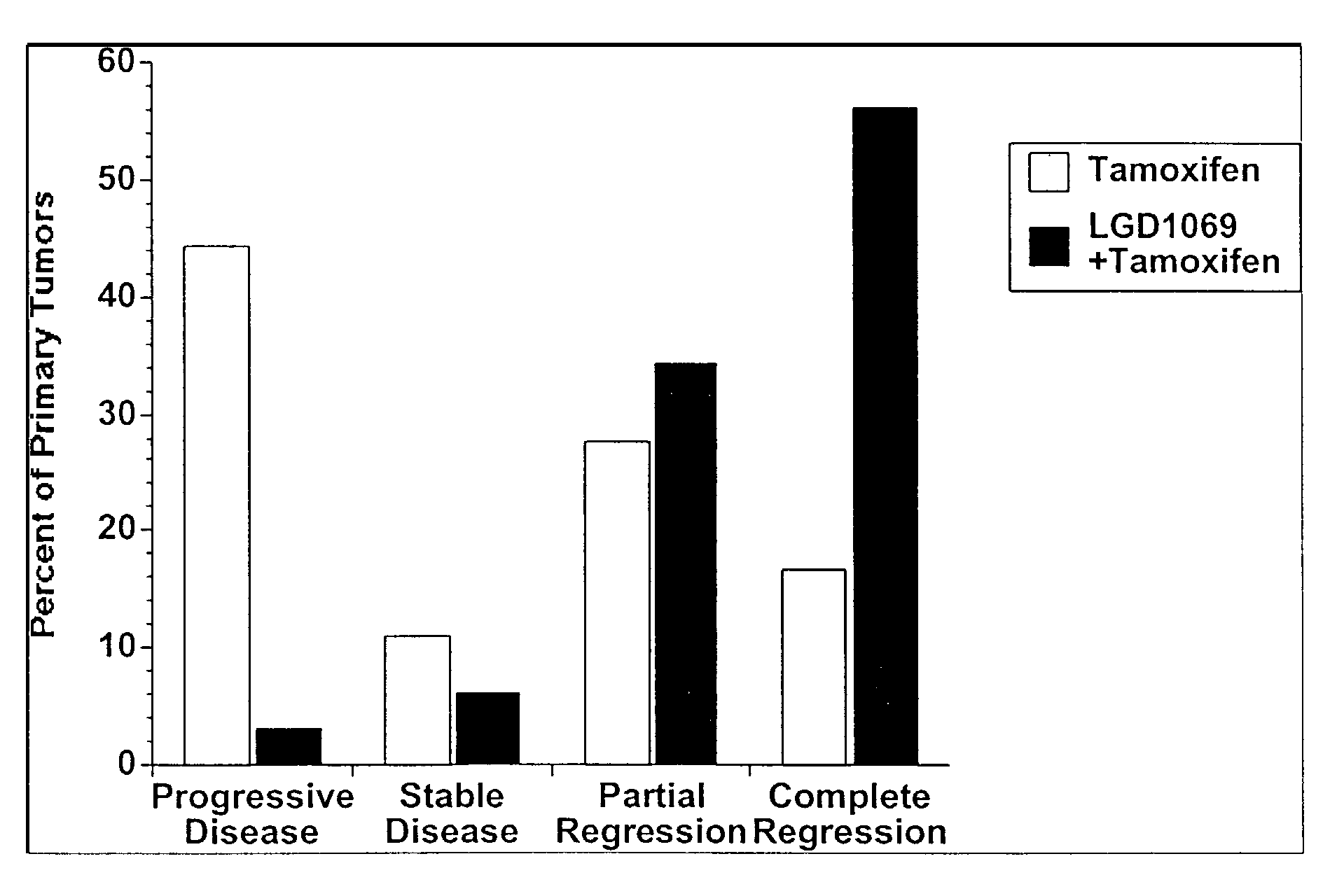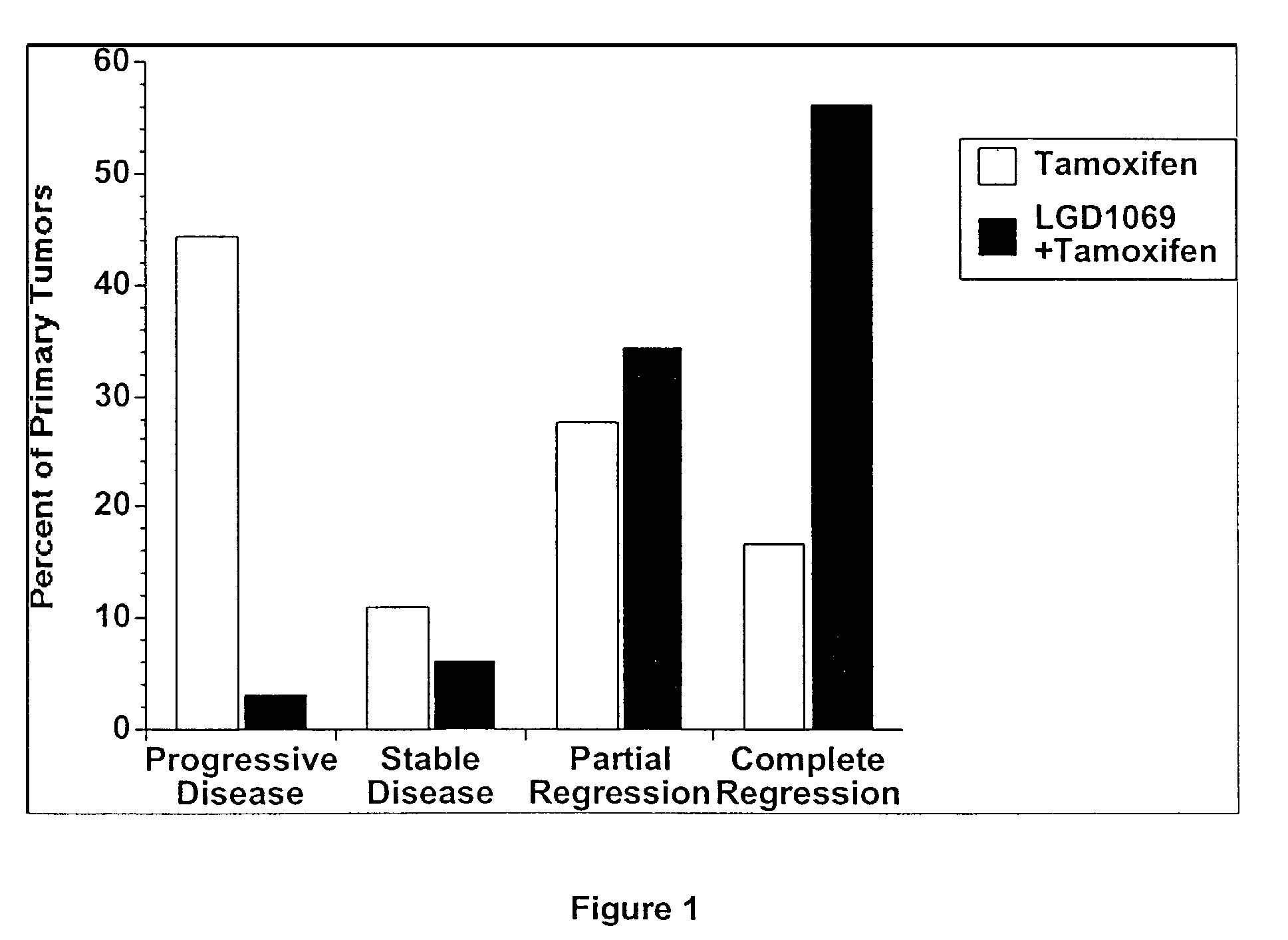Methods and pharmaceutical compositions for treatment of anti-estrogen resistant breast cancer using RXR modulators
a technology of rxr modulator and breast cancer, which is applied in the direction of drug composition, biocide, peptide/protein ingredient, etc., can solve the problems of adjuvant tamoxifen therapy suffering relapse, significant proportion of patients, and at best only effective in approximately 25 cases
- Summary
- Abstract
- Description
- Claims
- Application Information
AI Technical Summary
Benefits of technology
Problems solved by technology
Method used
Image
Examples
example 1
[0032]Mammary tumorigenesis was induced by administration of 50 mg / kg of N-nitroso-N-methylurea (NMU) (Sigma, St. Louis, Mo.) to 50 day old virgin female Sprague-Dawley rats (Harlan-SD, Indianapolis, Ind.). NMU was formulated as an aqueous solution of 10 mg / ml by wetting NMU powder with 3% acetic acid and dissolving it in sterile saline. Fresh solutions of NMU were injected within 30 minutes of preparation. The animals were injected in the tail vein with 5 mg NMU / 100 g body weight. Rats were housed in a USDA registered facility in accordance with NIH guidelines for the care and use of laboratory animals. All animals received food (Harlan Teklad LM485-7012, Indianapolis, Ind.) and acidified water ad libitum. Beginning five weeks after tumor induction, animals were examined for tumors twice a week. Tumors were measured with electronic calipers (Mitushoyo, Japan) and cross sectional areas were determined by multiplying the longest length of the tumor by the greatest perpendicular width...
example 2
[0035]Mammary tumors were induced in Sprague-Dawley rats as in the previous example with NMU and then, beginning one week after carcinogen treatment, animals were treated with low-dose tamoxifen (50 μg / kg, SC) to prevent formation of tumors. Tumors that grew in the presence of the low-dose tamoxifen were evaluated for tamoxifen resistance by increasing the dose of tamoxifen (800 μg / kg, SC), or by adding in LGD1069 (100 mg / kg, PO) to the therapy. The addition of LGD1069 to the therapy significantly reduced the amount of progressive disease in this model, as compared to treatment with tamoxifen.
example 3
[0036]Mammary tumors were induced in Sprague-Dawley rats as in Example 1. When tumors developed and reached an area of 75 mm2, animals were randomly assigned to one of three treatment groups and treated daily for six weeks with vehicle, LGD1069 (100 mg / kg), or tamoxifen (800 μg / kg).
[0037]After six weeks, in vehicle-treated control animals, 87% of the tumors continued to grow and progress, 8.7% were static, 4.3% partially regressed, and 0% completely regressed. In contrast, in LGD1069-treated animals, 11.1% of tumors continued to progress, 16.7% partially regressed, and 72.2% completely regressed. In tamoxifen-treated animals, 28.6% of tumors continued to progress, 4.8% remained static, 33.3% partially regressed, and 33.3% completely regressed. As shown, treatment with LGD1069 demonstrated significant antitumor efficacy on established mammary tumors and demonstrated greater efficacy than treatment with tamoxifen.
PUM
| Property | Measurement | Unit |
|---|---|---|
| Molar density | aaaaa | aaaaa |
| Molar density | aaaaa | aaaaa |
| Molar density | aaaaa | aaaaa |
Abstract
Description
Claims
Application Information
 Login to View More
Login to View More - R&D
- Intellectual Property
- Life Sciences
- Materials
- Tech Scout
- Unparalleled Data Quality
- Higher Quality Content
- 60% Fewer Hallucinations
Browse by: Latest US Patents, China's latest patents, Technical Efficacy Thesaurus, Application Domain, Technology Topic, Popular Technical Reports.
© 2025 PatSnap. All rights reserved.Legal|Privacy policy|Modern Slavery Act Transparency Statement|Sitemap|About US| Contact US: help@patsnap.com



